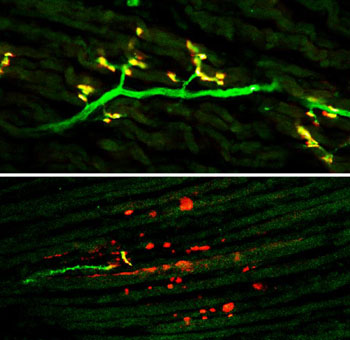MicroRNA Defect Triggers Motor Neuron Disease Symptoms in Mouse Model
By LabMedica International staff writers
Posted on 28 Dec 2015
A team of neurobiologists working with a mouse model has shown how the loss of a single microRNA (miRNA) caused newborn mice to die at birth while exhibiting symptoms of neuromuscular junction defects similar to those seen in human motor neuron diseases.Posted on 28 Dec 2015
MicroRNAs are a class of about 20 nucleotides-long RNA fragments that block gene expression by attaching to molecules of messenger RNA (mRNA) in a fashion that prevents them from transmitting the protein synthesizing instructions they had received from the DNA. With their capacity to fine-tune protein expression via sequence-specific interactions, miRNAs help regulate cell maintenance and differentiation. One miRNA, miR-218, is abundantly and selectively expressed by developing and mature motor neurons (motoneurons).

Image: The micrographs show the synapses between motor neurons and muscle that are normal in control mice (top). In mice lacking the microRNA molecule miRNA-218, neuromuscular junctions are severely defective and motor neurons undergo neurodegeneration (bottom). Pre-synaptic motor axons are in green, and post-synaptic acetylcholine receptors expressed by muscle are in red. Areas of overlap in yellow identify correctly formed neuromuscular junctions (Photo courtesy of the Salk Institute for Biological Sciences).
Investigators at the Salk Institute for Biological Studies (La Jolla, CA, USA) used the CRISPR-Cas9 gene editing technique to precisely eliminate those sections of DNA in the mouse genome that were responsible for generating miR-218.
CRISPRs (clustered regularly interspaced short palindromic repeats) are segments of prokaryotic DNA containing short repetitions of base sequences. Each repetition is followed by short segments of "spacer DNA" from previous exposures to a bacterial virus or plasmid. CRISPRs are found in approximately 40% of sequenced bacteria genomes and 90% of sequenced archaea. CRISPRs are often associated with cas genes that code for proteins related to CRISPRs. The CRISPR/Cas complex comprises a prokaryotic immune system that confers resistance to foreign genetic elements such as plasmids and phages and provides a form of acquired immunity. Since 2013, the CRISPR/Cas system has been used in research for gene editing (adding, disrupting, or changing the sequence of specific genes) and gene regulation. By delivering the Cas9 protein and appropriate guide RNAs into a cell, the organism's genome can be cut at any desired location.
The investigators reported in the December 18, 2015, issue of the journal Science that mutant mice lacking miR-218 died neonatally and exhibited neuromuscular junction defects, motoneuron hyperexcitability, and progressive motoneuron cell loss, all of which are hallmarks of motoneuron diseases such as amyotrophic lateral sclerosis (AML) and spinal muscular atrophy (SMA).
Gene profiling revealed that when functioning normally miR-218 modestly repressed a cohort of hundreds of genes that were neuronally enriched but are not specific to a single neuron subpopulation. Thus, the set of messenger RNAs targeted by miR-218 defined a neuronal gene network that was selectively tuned down in motoneurons to prevent neuromuscular failure and neurodegeneration.
"MicroRNAs that have previously been studied have been predominantly associated with defects in the development of nerve cells, called neurogenesis. And that is really what most people would expect to happen with our microRNA," said senior author Dr. Samuel Pfaff, professor of neurobiology at the Salk Institute for Biological Studies. "However, the neurogenesis in our experiment was completely intact. MicroRNAs are not dramatic on-off switches of genes in the cell in the way we think about other genetic regulators. Instead, microRNAs are the fine-tuning control of gene activity—another reason their role in cells has been harder to pinpoint."
"This really does open a new world of possibilities to another approach to understanding neurodegenerative diseases like these," said Dr. Plaff. "It breaks down a few common preconceptions about what microRNAs do in the nervous system, and that opens doors for people to start studying microRNAs as a class of molecules that might have significant links to many types of neurodegenerative disorders."
Related Links:
Salk Institute for Biological Studies














